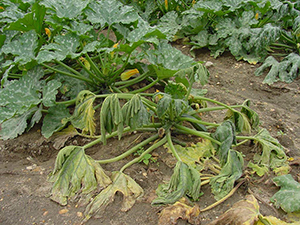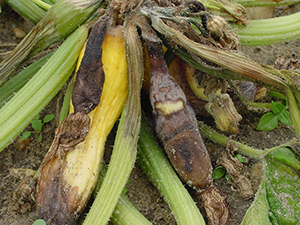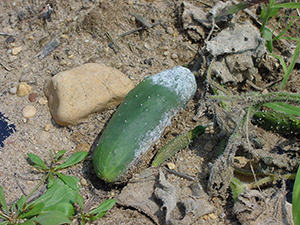Fact Sheet FS548
Phytophthora blight (Phytophthora spp.) is an important soil-borne fungal disease in the home garden. Phytophthora blight can infect tomato, pepper, eggplant, and cucurbit (pumpkin, squash) crops causing root, stem, and fruit rot. Losses to Phytophthora blight in the home garden can be serious if not controlled properly with proper cultural practices and crop rotations.
Phytophthora blight is caused by the fungus, Phytophthora capsici, and is an oomycete, which are commonly referred to as water molds. Free water and moisture are essential for the development of Phytophthora blight. Excessive water in the form of rainfall or overhead irrigation can lead to Phytophthora blight problems in the home garden. Poorly drained soils, when water is allowed to puddle on the soil surface, can also lead to serious Phytophthora problems. Phytophthora blight can develope under a wide range of temperatures with rainfall and humidity playing an important part in its development.
Infections in the home garden begin as root infections which develop into crown rot and stem infections, causing plants to become wilted. Wilted plants eventually die as the fungus spreads to other susceptible hosts via root-to-root contact and by inoculum (I.e., spores), which develop on the surface of crown and stem lesions. Spores can be spread to the canopy and fruit of infected hosts via wind or by splashing during rainfall and overhead irrigation events.
Symptoms of Phytophthora blight vary slightly by host and is easily diagnosed once symptoms are recognized.
Phytophthora Blight of Summer Squash
All cucurbit crops (summer and winter squash, pumpkins, watermelons) are susceptible to Phytophthora blight. Symptoms of root and crown rot of cucurbit crops begins with the wilting of young, actively growing plants. Healthy plants may suddenly wilt during hot days immediately after heavy rainfalls. Plants often look like they may be recovering, but suddenly collapse. Infected plants often retain their green color during wilting but eventually turn yellowish-brown and die. Crowns of infected plants develop a blackish-brown layer that often has a slimy appearance. Under ideal conditions, masses of white fungal fruiting bodies (spores) develop in infected crowns, which are spread via splashing water and wind to healthy plants.
Phytophthora Blight of Pumpkin
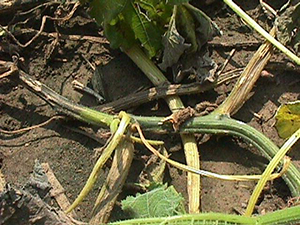
Pumpkin vine infected with Phytophthora blight.
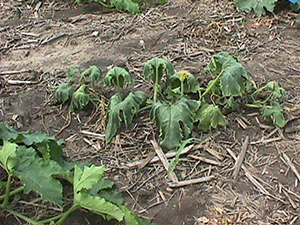
Pumpkin plant showing wilted symptoms.
Phytophthora blight can be a serious disease of pumpkin. Symptoms of Phytophthora blight on infected pumpkin are very similar to symptoms on summer squash. Infected plants may suddenly wilt and collapse.
Symptoms on infected vines include water-soaked lesions where vines turn blackish-brown and have a slimy appearance.
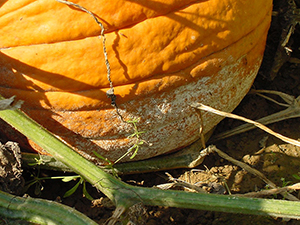
Mature pumpkin fruit with masses of white, slimy spores of Phytophthora blight.
Late in the growing season, Phytophthora blight may infect maturing green or ripe pumpkin fruit. Symptoms of Phytophthora blight on infected fruit include the production of masses of white, slimy spores which may develop on the undersides of infected fruit. As infection progresses, fruit will begin to become mushy and collapse. Spores from infected fruit may spread to other fruit and healthy plants via rainfall and through puddling water that is slow to drain off the soil surface. Once fruit are infected they are no longer good and should not be harvested. If the slightest symptoms begin to develop on fruit after harvest, they should be discarded.
Phytophthora Blight of Pepper and Eggplant
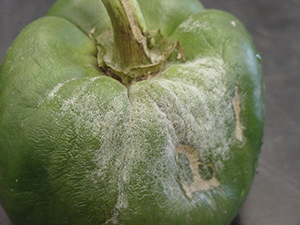
Fruit rot of bell pepper with masses of spores developing on infected fruit.
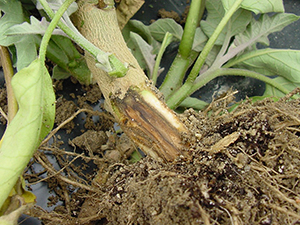
Symptoms of Phytophthora crown rot of pepper and eggplant.
Phytophthora blight is a serious disease of pepper and eggplant in the home garden. Like Cucurbit crops, Phytophthora blight can infect all parts of pepper and eggplant, leading to complete loss. Phytophthora blight can cause root, stem, and fruit rot in pepper and eggplant. Symptoms of crown rot include the development of blackish-brown lesions that start beneath the soil surface as a root rot and extend up the stem from the soil line as lesions develop. Under ideal conditions, masses of white spores will develop on infected stems. Spores are splashed from plant to plant via rainfall and overhead irrigation, and allowing water to puddle around the base of stems can exacerbate Phytophthora problems. Fruit can become infected by the aerial phase of Phytophthora blight. Spores from infected stems may splash up into the plant canopy causing lesions on leaves and fruit.
Buckeye Rot of Tomato
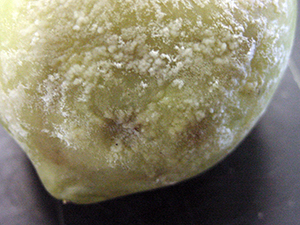
Sporulation of Buckeye rot on infected green tomato fruit.
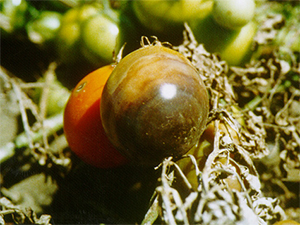
Buckeye rot of tomato with distinct concentric rings on infected green tomato fruit.
Buckeye rot affects immature green tomatoes that lay on the soil surface. On green fruit, buckeye rot will produce distinct brownish-black lesions that have a definite concentric or target-like appearance. In moist conditions, white fluffy fungal growth will develop on infected fruit. Over time, infected fruit will become soft and mushy. Excessively wet soils often lead to Buckeye rot problems. Staking, caging, or mulching tomato plants to keep fruit from coming into direct contact with the soil is a good way to reduce Buckeye rot.
Control Measures for Phytophthora Blight
There are a number of cultural practices that can be used to help reduce Phytophthora in the home garden. The first cultural practice to reduce Phytophthora in the home garden is to remove old plant debris.
Phytophthora blight can produce spores, which may overwinter in the soil or on infected plant debris. The next growing season, wintering spores may germinate and infect a susceptible host, thus restarting the Phytophthora disease cycle.
Proper sanitation measures can keep spores from overwintering and infecting the next crop. At the end of the growing season, all plant refuse should be removed and discarded, composted (if the pile is hot enough to kill the spores), or tilled into the soil. Any infected fruit should be removed during the growing season or at the end of the season.
Crop rotation is the primary means to help reduce Phytophthora blight in the home garden. Each year plant tomato, eggplant, pepper, and cucurbits in a new location away from areas where any of these crops have been grown in the past since these crops are all susceptible to Phytophthora. A minimum crop rotation of three years is considered essential to help reduce populations of soil-borne fungi, such as Phytophthora.
A second line of defense against Phytophthora blight is to alter the microclimate surrounding these crops. Fungi thrive in moist, humid conditions, particularly on leaves that remain wet for long periods of time. Tomatoes, eggplant, peppers, and cucurbits should be grown in a location of full sun with good soil drainage and plenty of air circulation to keep leaves dry.
Staking or caging of pepper, tomato, and eggplants to keep plants off the ground will allow more rapid drying of the plant. Watering should be performed in the morning to allow for sufficient drying time of the soil and plant canopy. Cultural practices which promote quick drying soils after irrigation are a good means to help reduce Phytophthora blight in the home garden. Mulching the soil under plants with composted leaves or straw mulch will help to keep spores from splashing up onto the canopy and prevent fruit, such as pumpkin and tomato, from coming into direct contact with the soil.
Along with cultural practices, there are preventative chemical fungicides that can be used for Phytophthora blight control. Always read and follow directions on the label of the chemical control you are using.
May 2020
Copyright © 2024 Rutgers, The State University of New Jersey. All rights reserved.
For more information: njaes.rutgers.edu.
Cooperating Agencies: Rutgers, The State University of New Jersey, U.S. Department of Agriculture, and Boards of County Commissioners. Rutgers Cooperative Extension, a unit of the Rutgers New Jersey Agricultural Experiment Station, is an equal opportunity program provider and employer.


